India
Skandashram: Ramana's Cave
After my first cold bucket bath and a
lunch that was more like a feast, I
proceeded to the back entrance of Ramana
ashram, past the peacocks and monkeys
playing in the trees. There is stone
filled path leading up to the two places
where Ramana did much of his sadhana for
over three decades, Skandashram, a small
cave about 800 feet about the city, where
he spent 6 years, and Virupaksha cave,
where he meditated for over 18 years.
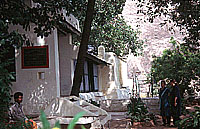 Virupaksha cave is named after a great
yogi and saint of Thiru who preceeed
Ramana. He had a large following and
one day, he told his students that he
wanted to be alone in the cave for some
time. After a while, the students started
to wonder and when they entered the cave,
all they found was a pile of ashes. Ramana
subsequently took over the cave and formed
the ashes into a tall pile. Virupaksha cave
is about 200 feet below Skandashram.
Virupaksha cave is named after a great
yogi and saint of Thiru who preceeed
Ramana. He had a large following and
one day, he told his students that he
wanted to be alone in the cave for some
time. After a while, the students started
to wonder and when they entered the cave,
all they found was a pile of ashes. Ramana
subsequently took over the cave and formed
the ashes into a tall pile. Virupaksha cave
is about 200 feet below Skandashram.
I proceeded to the back gate of Ramana ashram,
past a group of villagers working on a
small stream bed that flows through the back
area of the ashram.
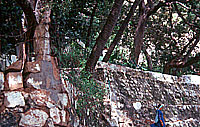 These folks live in a
village just behind the back wall of the
ashram, and are employed as manual laborers.
Just as in so many places, the men shovel
out the dirt, place it in a small bowl,
which is placed on one of the womens' head
and they cart the dirt off to parts unknown.
Their neck muscles must be so, so strong.
One of the women has a yellow face, which
is a common phenonmena in South India. At
first I thought it was some strange Hindu
ritual, but someone eventually told me that
it was just a beauty secret of the women -
they spread tumeric on their face for healthy
skin! It does make the women appear a bit
ghostly, in comparison to the dark brown
skin of the average South Indian.
These folks live in a
village just behind the back wall of the
ashram, and are employed as manual laborers.
Just as in so many places, the men shovel
out the dirt, place it in a small bowl,
which is placed on one of the womens' head
and they cart the dirt off to parts unknown.
Their neck muscles must be so, so strong.
One of the women has a yellow face, which
is a common phenonmena in South India. At
first I thought it was some strange Hindu
ritual, but someone eventually told me that
it was just a beauty secret of the women -
they spread tumeric on their face for healthy
skin! It does make the women appear a bit
ghostly, in comparison to the dark brown
skin of the average South Indian.
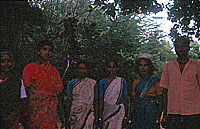 After I passed through the iron gate of
the ashram, a cross road is encountered
which leads to several residential villages
along the base of Arunachala mountain. At
the crossroad (rather 'crosspath') is a nice
old mud pit which a family of piggies were
enjoying in the midday sun. The actual path
up the mountain is laid out quite nicely,
a stone path that took quite a bit of work.
As I walked up the path, I ran into several
men and one of them seemed to start looking
after me, as if he was trying to be my guide,
which basically means he wanted money from
me. I mean, this is a well defined rock path,
how much guidance do you need? But he kept
ahead of me up the mountain, like he was
doing me some big favor.
After I passed through the iron gate of
the ashram, a cross road is encountered
which leads to several residential villages
along the base of Arunachala mountain. At
the crossroad (rather 'crosspath') is a nice
old mud pit which a family of piggies were
enjoying in the midday sun. The actual path
up the mountain is laid out quite nicely,
a stone path that took quite a bit of work.
As I walked up the path, I ran into several
men and one of them seemed to start looking
after me, as if he was trying to be my guide,
which basically means he wanted money from
me. I mean, this is a well defined rock path,
how much guidance do you need? But he kept
ahead of me up the mountain, like he was
doing me some big favor.
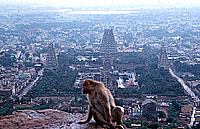 We passed a sign for a very worthy cause
for Arunachala mountain - a reforestation
program that has been started, since the
mountain has been stripped almost barren
of trees, being used by the folks of
Thiru for firewoood. The program was
started by a westerner and takes donations
to sponsor a group of trees, each of
which is numbered and has a rock wall
around it for protection. Apparently
the whole area around Arunachala mountain
was once a fairly dense jungle, and
circumambulating the mountain was a
very dangerous journey, with the
possibility of encountering a large
jungle cat or snake. But nowadays, the
most danger is from vewhicular traffic.
We passed a sign for a very worthy cause
for Arunachala mountain - a reforestation
program that has been started, since the
mountain has been stripped almost barren
of trees, being used by the folks of
Thiru for firewoood. The program was
started by a westerner and takes donations
to sponsor a group of trees, each of
which is numbered and has a rock wall
around it for protection. Apparently
the whole area around Arunachala mountain
was once a fairly dense jungle, and
circumambulating the mountain was a
very dangerous journey, with the
possibility of encountering a large
jungle cat or snake. But nowadays, the
most danger is from vewhicular traffic.
The path to the caves is steep at the
beginning, but not that steep as to
make it difficult for a non-hiker. Some
people do the hike in their bare feet.
About 10 minutes into the ascent one
is given a wonderful view of the
the lands around Thiru - one can see
individual mountains and hills dotting
the landscape - it seems very unusual
to see scattered non-connected mountains,
no semblance of a mountain range. And
many of those mountains have a small village
at its base as well as a temple on top.
 However, the town of Thiruvannamalai is
hidden from view until one is almost at
the caves. The mountain itself is fairly
nondescript, with a few rock walls, and
a light on top at night. In addition
to the reforestation program, there was
an aggressive drive to keep people from
living on the mountain over the years,
which for the most part has been successful.
However, the town of Thiruvannamalai is
hidden from view until one is almost at
the caves. The mountain itself is fairly
nondescript, with a few rock walls, and
a light on top at night. In addition
to the reforestation program, there was
an aggressive drive to keep people from
living on the mountain over the years,
which for the most part has been successful.
But there are a few sadhus and yogis who do make the mountain home. One famous Baba lives near the top of the mountain, spending most of his time in meditation, and apparently only drinks one or two glasses of milk a day for nourishment. That's it. People can climb to the top to get his blessing, but if you disturb him in meditation, he apparently can get quite upset and will throw rocks at the trespassers. I didn't get a chance to climb to the top, so I do not know if these rumors of his moodiness are true.
Just before reaching the first cave, known as Skandashram, the vista opens up to the entire town of Thiruvannamalai. The huge Arunachleswar temple stands majestically just below you, near the base of the mountain, its nine towers of various heights overshadowing the rest of the town.
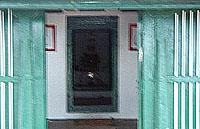 Arriving at Skandashram, it is really
a small building built into the
side of the mountain, with a small courtyard
and two inner chambers. After taking off
one's shoes, one can sit in the outer
chamber and look into the small 5 foot
square inner chamber, which can hold
at most two or three meditators. Fortunately
when I arrived, there was an open pillow in
the inner chamber, and I proceeded to sit
for a while. It was, needless to say, a very
powerful place. Some places are so imbued
with spiritual force that it can be felt
as a pressure on the body, and this place
is certainly one of them. I noticed that
discursive thoughts disappeared easily
and one could sit free of thought
generation, to enjoy that or to take
on any practice as desired, such as
the "Who Am I" enquiry that Ramana gave
to the the world.
Arriving at Skandashram, it is really
a small building built into the
side of the mountain, with a small courtyard
and two inner chambers. After taking off
one's shoes, one can sit in the outer
chamber and look into the small 5 foot
square inner chamber, which can hold
at most two or three meditators. Fortunately
when I arrived, there was an open pillow in
the inner chamber, and I proceeded to sit
for a while. It was, needless to say, a very
powerful place. Some places are so imbued
with spiritual force that it can be felt
as a pressure on the body, and this place
is certainly one of them. I noticed that
discursive thoughts disappeared easily
and one could sit free of thought
generation, to enjoy that or to take
on any practice as desired, such as
the "Who Am I" enquiry that Ramana gave
to the the world.
I stayed for about a half hour in the inner chamber as people came and went, mostly European westerners, here to visit or permanent residents of South India. Afterwards, I went out of the courtyard and just hung out on a rock overlooking the town below. I did notice that the noise of the town drifted up to this area, which to a small degree ruined the peacefulness, with honking horns abounding. But the mountain itself is a powerful place, and the same freedom from discursive thought could be found just by being on the mountain - it is a very wonderful place and a great advantage for meditative practice. On the way down I passed a couple of young men selling small statues, a bit of commercialism that has infiltrated the mountain, but not to an annoying degree, thankfully.
I made it a goal to go to the Virupaksha cave in the next day or so. It is situated just below Skandashram about 700 feet above the town, a place in which Ramana meditated for 17 years.
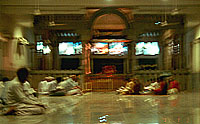 The late afternoon was spent in the large
hall that houses Ramana's samadhi site.
I would circumambulate the large altar
at least three times and then take a seat
while an hour's worth of Vedic chanting
occurred, in which men and women would
alternate reading a verse - it became
very hypnotic and conducive to simply
being still. And not long afterwards,
it was time for another wonderful dinner
in the dining hall. At night, I would
spend a some time in the adjoining
meditation room that held the couch
that Ramana sat on for years.
The late afternoon was spent in the large
hall that houses Ramana's samadhi site.
I would circumambulate the large altar
at least three times and then take a seat
while an hour's worth of Vedic chanting
occurred, in which men and women would
alternate reading a verse - it became
very hypnotic and conducive to simply
being still. And not long afterwards,
it was time for another wonderful dinner
in the dining hall. At night, I would
spend a some time in the adjoining
meditation room that held the couch
that Ramana sat on for years.
Circumambulating the Inner Loop
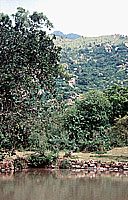 The next day I did a circumambulation
of Arunachala mountain on the inner
loop, which for the most part frees
one from having to walk on paved streets.
After padding my blistered feet, I took
a left after the back entrance of Ramana
ashram, and moved through various fields
and pastures. The going was difficult
at first, in the sense of trying to stay
on the path, which was not clearly marked.
But after a while, the orange and white
markers were easily found. Even though
it rained that morning, it was very hot
(I went just after lunch), and it was
a bit of a workout. I passed many a
goat and cattle herder, sometimes stopping
for pictures or giving out pens, and
of course, a rupee or two. Everyone has
a hand out it seems.
The next day I did a circumambulation
of Arunachala mountain on the inner
loop, which for the most part frees
one from having to walk on paved streets.
After padding my blistered feet, I took
a left after the back entrance of Ramana
ashram, and moved through various fields
and pastures. The going was difficult
at first, in the sense of trying to stay
on the path, which was not clearly marked.
But after a while, the orange and white
markers were easily found. Even though
it rained that morning, it was very hot
(I went just after lunch), and it was
a bit of a workout. I passed many a
goat and cattle herder, sometimes stopping
for pictures or giving out pens, and
of course, a rupee or two. Everyone has
a hand out it seems.
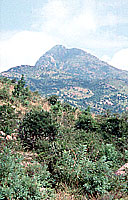 I made an effort to see how the mountain
would change as I walked around it, and try
to feel if I was walking in a large circle.
But it always seemed that I was walking in
a straight line and I wondered if I heading
towards Madras or parts unknown. It still
confounded me that I was actually walking
around this mountain. The path, being
clearly marked, led me through various
types of terrain, now mostly rocky and
shrublike terrain, till about 2 1/2 hours
into the journey, one is dumped onto a
paved road leading into downtown Thiru.
Every so often, I would look at the mountain
to keep attention to the reason why I was
doing this "hike", and I employed the "Om
Namah Shivaya" mantra often, as this mountain
is worshipped as a seat of Lord Shiva.
I made an effort to see how the mountain
would change as I walked around it, and try
to feel if I was walking in a large circle.
But it always seemed that I was walking in
a straight line and I wondered if I heading
towards Madras or parts unknown. It still
confounded me that I was actually walking
around this mountain. The path, being
clearly marked, led me through various
types of terrain, now mostly rocky and
shrublike terrain, till about 2 1/2 hours
into the journey, one is dumped onto a
paved road leading into downtown Thiru.
Every so often, I would look at the mountain
to keep attention to the reason why I was
doing this "hike", and I employed the "Om
Namah Shivaya" mantra often, as this mountain
is worshipped as a seat of Lord Shiva.
After being alone in much stillness for
most of my trip, the last thing I wanted
was to negotiate the noisy downtown area,
but I had no choice. The last part of the
journey leads one right past the walls
of the Arunachleswar temple then towards
the other side of town, where Ramana
ashram was situated.
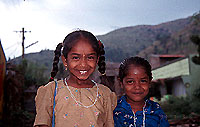 On the way I stopped for
a refreshing coconut drink - vendors
simply chop off the top of a coconut
with a machete and stick in a straw for
a most delicious drink of coconut milk.
I also encountered two very young and
charming schoolgirls around 6 years of
age, who charmed several pens and pieces
of candy off of me. They were so cute
that I took pictures of them.
On the way I stopped for
a refreshing coconut drink - vendors
simply chop off the top of a coconut
with a machete and stick in a straw for
a most delicious drink of coconut milk.
I also encountered two very young and
charming schoolgirls around 6 years of
age, who charmed several pens and pieces
of candy off of me. They were so cute
that I took pictures of them.
Virupaksha Cave
On my last day at Ramana Ashram, I took the rock path to Virupaksha cave, just below Skandashram. Between Skandashram and Virupaksha is a small stream from which I took the opportunity to receive a blessing - a holy mountain must have holy water! I drenched my head with water from the stream and proceeded the steep path to Virupaksha cave. But when I got there, it was closed, but fortunately the priest who takes care of this cave came about 10 minutes later. This cave is really not that far up the mountain, and there is a small family living just below the cave.
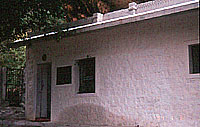 The cave itself is created by a huge
boulder, which is now surrounded in
part by a building and courtyard. It
is much larger than the inner Skandashram
cave, and also very powerful, a great
place to sit and meditate, and I took
advantage of being the only person there
for a long time. The cave itself can seat
about 10 people. Again, the spiritual
potency of the cave easily brought attention
to rest and the cessation of discursive
thought. I also took time again to just
be on the mountain - in comparison to
the noisy downtown, this place was heavenly,
such a sanctuary. I watched as two men went
past Skandashram to climb to the top of
Arunachala mountain, in sandals, no less.
Though the mountain isn't huge, somewhere
about 2700-3000 feet high, that's a call for
good footwear in my book!
The cave itself is created by a huge
boulder, which is now surrounded in
part by a building and courtyard. It
is much larger than the inner Skandashram
cave, and also very powerful, a great
place to sit and meditate, and I took
advantage of being the only person there
for a long time. The cave itself can seat
about 10 people. Again, the spiritual
potency of the cave easily brought attention
to rest and the cessation of discursive
thought. I also took time again to just
be on the mountain - in comparison to
the noisy downtown, this place was heavenly,
such a sanctuary. I watched as two men went
past Skandashram to climb to the top of
Arunachala mountain, in sandals, no less.
Though the mountain isn't huge, somewhere
about 2700-3000 feet high, that's a call for
good footwear in my book!
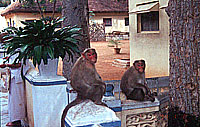 Doing a similar routine, of circumambulating
the mountain, visiting the mountain caves
and spending time at the samadhi site, not to
mention the wonderful meals, the 5 days I had a Ramana
ashram went quickly. I packed up my room, and
donated a lot of my leftover food, medicine,
clothing and assorted items to Ramana ashram.
They are not only an ashram for residents but
a place where all the poor and sadhus of
Thiruvannamalai can receive a free meal at
11:00am as well as medical care. The 11:00am
lineup of saffron robed sadhus is quite a site,
many carrying the traditional small metal pail
in which water or food is carried. Some of these
sadhus just look so cool, with long flowing white
hair and such.
Doing a similar routine, of circumambulating
the mountain, visiting the mountain caves
and spending time at the samadhi site, not to
mention the wonderful meals, the 5 days I had a Ramana
ashram went quickly. I packed up my room, and
donated a lot of my leftover food, medicine,
clothing and assorted items to Ramana ashram.
They are not only an ashram for residents but
a place where all the poor and sadhus of
Thiruvannamalai can receive a free meal at
11:00am as well as medical care. The 11:00am
lineup of saffron robed sadhus is quite a site,
many carrying the traditional small metal pail
in which water or food is carried. Some of these
sadhus just look so cool, with long flowing white
hair and such.
Dr. Murthy booked me a cab to Madras - Ramana ashram has its own taxi service - for about $30 US you can go to and from Madras to Thiru, which is a four hour cab ride. Quite a service. I gave a donation for my time at Ramana ashram, since they do not charge for a stay there.
Coming Home
I looked forward to coming home, and seeing my wife Annie for the first time in weeks, but also felt a bit apprehensive about going back - I felt like I really was absorbed into the psyche of India. But I did look forward to a place where things worked reasonably and efficiently!
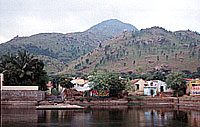 Before I left Thiruvannamalai, I asked my driver
to stop at this special 'tank' that was good
for purification, which was along the circumambulation
route. He replied that we could do another
circumambulation by car for an extra 100 rupees. I
said sure - I was told that it was auspicious to
circumambulate Arunchala three times - OK, so once
was in a taxi, is that so wrong?
Before I left Thiruvannamalai, I asked my driver
to stop at this special 'tank' that was good
for purification, which was along the circumambulation
route. He replied that we could do another
circumambulation by car for an extra 100 rupees. I
said sure - I was told that it was auspicious to
circumambulate Arunchala three times - OK, so once
was in a taxi, is that so wrong?
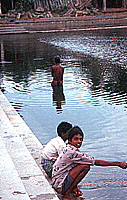 The ride back to Madras was somewhat difficult.
First off, my drvier had a cold, and was hawking
loogies out the window for the first hour, and
was constantly picking his nose. Yecch. Then it
started raining, and raining real hard. At one
point we stopped for a train - the crossing
guard rail is lowered manually and can take
a painfully long time to be raised (since they
do not have communication apparently, they lower
the bar when they think the train is coming, and
often the train is late or very late). During
this wait, a poor young girl of nine was selling
snacks in the pouring rain, sans umbrella or
any other form of protection - though it is
stays fairly warm in South India, wet is wet,
and it felt perverse and ironic that I was
nice and dry in the taxi while this girl was
exposed to the elements. But that's the way
it is for untold numbers of people.
The ride back to Madras was somewhat difficult.
First off, my drvier had a cold, and was hawking
loogies out the window for the first hour, and
was constantly picking his nose. Yecch. Then it
started raining, and raining real hard. At one
point we stopped for a train - the crossing
guard rail is lowered manually and can take
a painfully long time to be raised (since they
do not have communication apparently, they lower
the bar when they think the train is coming, and
often the train is late or very late). During
this wait, a poor young girl of nine was selling
snacks in the pouring rain, sans umbrella or
any other form of protection - though it is
stays fairly warm in South India, wet is wet,
and it felt perverse and ironic that I was
nice and dry in the taxi while this girl was
exposed to the elements. But that's the way
it is for untold numbers of people.
As we reached the outskirts of Madras, with the new Ford plant, it began to rain extremely hard, and I notice numerous trucks that skidded off the road into the wide grassy area between the lanes of the highway. They looked like dead elephants. Many trucks were bein unloaded by replacement trucks. In other areas, various brutal car crashes were left to display the nastiness of two metal machines smacking into each other. Apparently, since there is no concept of AAA or any kind of road service, these vehicles are left to rot on the side of the road or in the road itself. Often a broken down truck is being fixed right in the roadway, simply blocked off by piles of rock, so that other vehicles do not smash into it. I think a few drivers died or were seriously hurt during that rainstorm.
After a seeming eternity, I was dropped off at the Hotel Chandra, next to the Imperial Hotel. This was a 3 star hotel, and I would have stayed at a fancier one, but it was 7:30pm already and my flight was leaving at 2:00AM. So it seemed a waste to spend all that money for a place to rest and take a shower. I felt burnt already and had not even started to do my plane thing.
I was going straight from India to California, which by the way, is exactly on the other side of the earth as India. My taxi driver from Thiru stayed around so he could take me to the airport (and get a good tip from a westerner, methinks), and I started my journey home.
The first flight was 9 hours, to Frankfurt, and I managed to sleep for over half the time, but when we arrived in Frankfurt, it was in the midst of a major snowstorm. Oh shit, I just wanna get home. And it was so cold in the airport, and many flights were being cancelled. But the big 747s weren't being cancelled, and after a 3 hours wait, we taxied out fairly on time. But we waited in the plane for another 2 hours to get de-iced, as only one runway was open. We finally took off for the longest 10 hours of my life - there were moments whrere I wanted to scream and open the damn door, but cooled down eventually. After another seeming eternity, I saw the beautiful San Francisco Bay area, and felt re-energized. Home!
Final Thoughts
I could write a lot about how my trip to
India affected me, but suffice to say
it had a deep, deep affect on me, and
it will take more time for me to assimilate
the changes. India humbled me, inspired me,
gave me a much, much greater perspective
on life, death, existence, pain, suffering
and compassion. It showed me the gaps in
my own spiritual evolution, and proceeded
to do the work to fill those gaps.
 It broke
my heart, in a way that was not superficially
emotional, but very deep way - somehow, the
spiritual blessings I received and the
almost constant association of poverty,
disease, overpopulation, filth and limitations
broke a band of hardened immunity around
my heart and gave me a visceral lesson in
the Buddhist concepts of impermanence and
dukkha (suffering). Living in America
and especially one of the many wealthier
suburbs, the subtle idea that one could
stay at distance from the suffering of
others was smashed. Here in America, our
dark side is tidily tucked away in the
inner cities and 'bad' neighborhoods that
we cautiously avoid.
It broke
my heart, in a way that was not superficially
emotional, but very deep way - somehow, the
spiritual blessings I received and the
almost constant association of poverty,
disease, overpopulation, filth and limitations
broke a band of hardened immunity around
my heart and gave me a visceral lesson in
the Buddhist concepts of impermanence and
dukkha (suffering). Living in America
and especially one of the many wealthier
suburbs, the subtle idea that one could
stay at distance from the suffering of
others was smashed. Here in America, our
dark side is tidily tucked away in the
inner cities and 'bad' neighborhoods that
we cautiously avoid.
And the utter shock of going from a land
of innumerably impoverished people to
Christmas time frenzied holiday shopping
was like going from one form of chaos
to some other form of perverted chaos.
 As I've said, the re-entry into this culture was
much more difficult than the entry into
India. I read somewhere in India that
the number of natural resources that
are used by one American can support
200 - 300 Asians. I don't know if those
figures are accurate, but even if they
are off by 2/3 or 3/4, this is still a
sign of a bizarre disparity that may
be considered appalling.
As I've said, the re-entry into this culture was
much more difficult than the entry into
India. I read somewhere in India that
the number of natural resources that
are used by one American can support
200 - 300 Asians. I don't know if those
figures are accurate, but even if they
are off by 2/3 or 3/4, this is still a
sign of a bizarre disparity that may
be considered appalling.
In India, I saw most people bound to a certain destiny, with few choices in life due to poverty, while in America (or the west in general), we are often tortured by the choices and possibilities in life, and unsatisfied by what some would say are excesses. But at the same time, we are also given the opportunity, like our fellow Indian, to take up spiritual practice and discover the nature of cultural chaos that we live in.
So let me say to anyone out there reading this, thanks for your replies to this travelogue, and if you don't have a spiritual practice, do start as soon as you can, and if you do, keep it on and discover the nature of self and existence. And all the while be kind to others and most of all, to yourself.
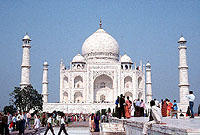
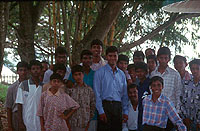
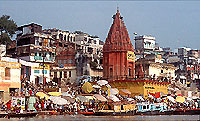
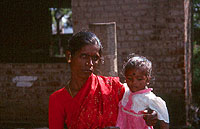
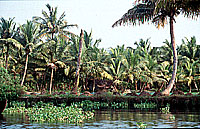
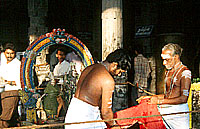

Back
Page 12.
